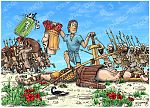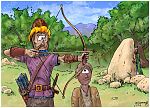Bible Cartoon: 1 Samuel 18 - Saul jealous of David - Scene 04 - Hurled spear
Click on Add to cart button below shopping cart.
Purchased Bible Cartoons do not have watermarks. Links to Cartoons provided on email once purchase is completed.Bible Book: 1 Samuel
Bible Book Code: 0901801001
Scene no: 1 of 1
Bible Reference & Cartoon Description
1 Samuel 18:10-11 (NLT)
10 The very next day a tormenting spirit [1] from God overwhelmed Saul, and he began to rave in his house like a madman. David was playing the harp, as he did each day. But Saul had a spear in his hand, 11 and he suddenly hurled it at David, intending to pin him to the wall. But David escaped him twice.
[1]
Or, an evil spirit.
DRAWING NOTES:
TIME OF DAY:
Daytime, but unspecified in the Bible quote above.
LIGHTING NOTES:
Warm yellow torch light comes from above in this scene.
CHARACTERS PRESENT:
Angry-looking king Saul, throwing his spear at a surprised looking David.
RESEARCH/ADDITIONAL NOTES:
This scene was originally drawn for a “bad Day” mug design, but I have decided to put it in the Bible Cartoon collection as well.
Here is the scene without the figures.

1 Samuel 18 – Saul jealous of David – Scene 04 – Hurled spear – Background
Click on the colour bar below to view/buy this Background:
Background of 1 Samuel 18 – Saul jealous of David – Scene 04 – Hurled spear
Saul’s skin, hair & clothing colourings & designs are taken from a previously drawn scene (1 Samuel 17 – David & Goliath – Scene 08 – Saul’s armour) which was the first time I had ever drawn Saul. That scene includes his golden crown with the word “Saul” embossed in Hebrew script.
1 Samuel 17 – David & Goliath – Scene 04 – Israelites run is the previous scene which established David’s skin, hair & clothing colourings.
I used a special effect in Corel PhotoPaint to create the red zig zap lines behind Saul, which are intended to give a sense of his radiating anger & ravings.
This scene takes place at king Saul’s stronghold in Gibeah. Part of an article I found about this location is quoted below.
“GIBEAH, GEBA (Heb. גֶּבַע ,גִּבְעָה; “hill”), a central city in the territory of Benjamin and the royal capital at the time of Saul. It was situated on the main road from Judah to Mount Ephraim (Judg. 19:11–13), near the Jerusalem–Shechem road. The territory of the tribe of Benjamin is characterized by a hilly terrain. The biblical sources relating to this territory contain a large number of place names based on the root g-b-ʿ, the stem for the Hebrew word meaning “hill.” These include the name Gibeon, Geba (1 Sam. 14:5), and Gibeah (Judg. 19.12; 1 Sam. 14:2), the latter thought to be identified at Tell el-Ful. There are also longer versions of these names such as Geba of Benjamin (1 Sam. 13:16), Gibeah of Benjamin (1 Sam. 13:2), and Gibeath Haelohim (1 Sam 10:5).
According to the story in Judges 19–21 the city was destroyed during the civil war that ensued as a result of the atrocities committed by the people of Gibeah against the concubine from Judah. Later Gibeah became one of the Philistines strongholds in the highlands (1 Sam 10:5). According to 1 Samuel 10:26; 11:4 Saul came from Gibeah; however, the genealogical lists in 1 Chronicles 8:29; 9:35 suggest that Saul’s ancestral home was at Gibeon. After the battle of Michmash (1 Sam. 13–14) Gibeah became Saul’s capital and was renamed after him as “Gibeah of Saul” (1 Sam. 15:34).
After the schism Gibeah became an important strategic city on the northern border of Judah. It is also mentioned in Isaiah 10:29 in Sennacherib’s march through the region north of Jerusalem…
…The evidence so far indicates that there was only one solitary massive tower, not a fortress, during Tell el-Ful Period ii (i.e., the period of Saul). It is possible, however, that at the time of Saul only the tower was necessary and that additional walls were added later.”
[Source: https://www.encyclopedia.com/religion/encyclopedias-almanacs-transcripts-and-maps/gibeah-geba]
Bible Doctrine Notes
18:10 EVIL AND SUFFERING, Divine Origin (2.31A)
[Same note as 1 Samuel 16:13-23]
The Bible holds to monotheism, the belief in a single God. In the time of Saul and David that truth separated Israel from their surrounding neighbours who believed in a pantheon of many gods.
Monotheism forces believers to account for evil and suffering in light of the one true God as well. God allows evil to exist. The spirit is the power that drives a person’s will and emotions. True life, under God, exists when a person allows God’s Holy Spirit to control and direct their life choices. Other wise evil controls the person. Ultimately, in a world with only one God, even an evil spirit must logically be a part of that God’s creation. In the case of king Saul, God used an evil spirit to punish an unfaithful, disobedient member of God’s people. To speak of an evil spirit from God does not lessen the moral responsibility of the person it influences/affects nor does it place moral blame on God. The evil spirit’s influence was evidenced by king Saul’s depression, violent mood swings, and irrational threats. The evil spirit still remains under God’s control.





